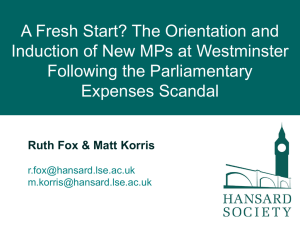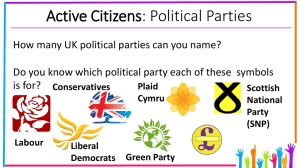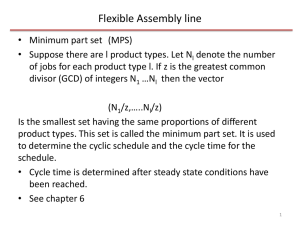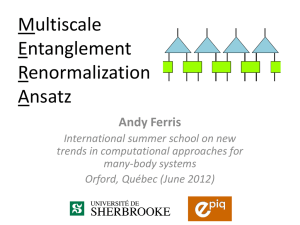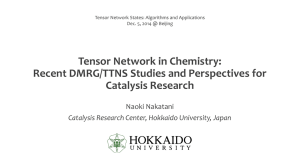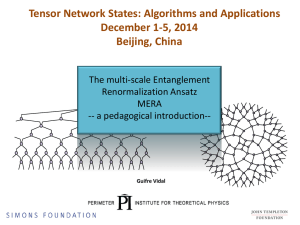intro to tensor networks
advertisement
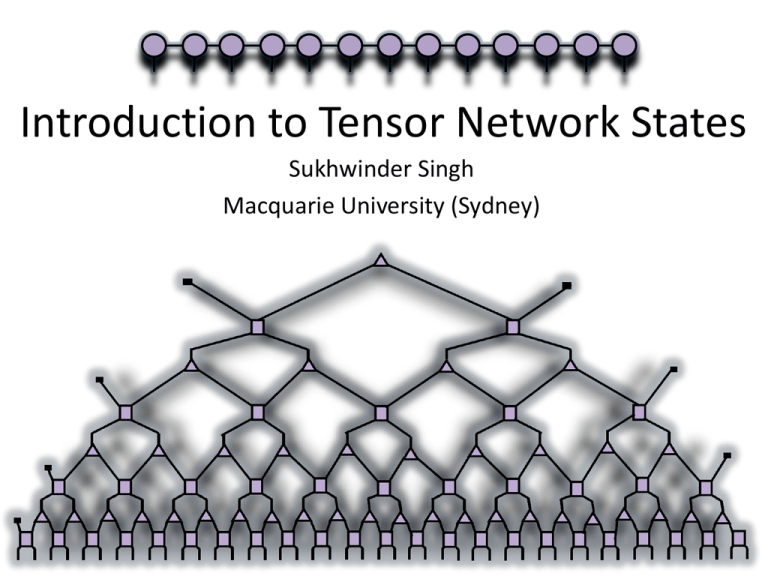
Introduction to Tensor Network States Sukhwinder Singh Macquarie University (Sydney) Contents • The quantum many body problem. • Diagrammatic Notation • What is a tensor network? • Example 1 : MPS • Example 2 : MERA Quantum many body system in 1-D 1 N 2 }D dim (V ) D Total H ilbert Space : V N V N D im ension = D H uge ! i1i2 iN i1i2 iN i1 i2 iN N How many qubits can we represent with 1 GB of memory? Here, D = 2. 2 8 2 N 30 N 27 To add one more qubit double the memory. But usually, we are not interested in arbitrary states in the Hilbert space. Typical problem : To find the ground state of a local Hamiltonian H, H h12 h 23 h34 ... h N 1, N Ground states of local Hamiltonians are special L im ited C orrelation s an d E n tan glem en t. C (l ) O x O x l S ( l ) i log i i Properties of ground states in 1-D 1) Gapped Hamiltonian C (l ) e S ( l ) const l / 2) Critical Hamiltonian C (l ) l a a0 S ( l ) log( l ) l We can exploit these properties to represent ground states more efficiently using tensor networks. V N Ground states of local Hamiltonians Contents • The quantum many body problem. • Diagrammatic Notation • What is a tensor network? • Example 1 : MPS • Example 2 : MERA Tensors Multidimensional array of complex numbers Ti1i2 b b a a 1 2 3 a a B ra : K et : * 1 * 2 M a trix * 3 M 11 M 21 M 31 ik M 12 M 22 M 3 2 c R a n k-3 T en so r M 11 c 1 M 21 M 31 M 12 M 22 M 3 2 N 11 c 2 N 21 N 31 N 12 N 22 N 3 2 Contraction = a a M a b M b ab b Contraction a Q P R c = Rac a b c Pab Qbc b contraction cost a b c Contraction b b Q S = a P e P afe efg R c a c S abc g f Q fbg R egc Trace a z M aa M = b P b = a a R a c Pab Rabcc c Tensor product a e ab f cd c b d e ab (R esh ap in g) b a Decomposition M M T 1 Q D Q = = = U U S S V V Decomposing tensors can be useful M d d = P Q d d d Rank(M) = Number of components in M = d 2 Number of components in P and Q = 2 d Contents • The quantum many body problem. • Diagrammatic Notation • What is a tensor network? • Example 1 : MPS • Example 2 : MERA Many-body state as a tensor i1i2 i1i2 iN i1 i2 iN i1 i2 iN iN Expectation values O O i1 i2 i1i2 iN Ok iN con traction cost = O D N * i1i 2 iN Correlators O1 O2 O1O 2 con traction cost = O D N Reduced density operators T rs b lo ck con traction cost = O D N Tensor network decomposition of a state Essential features of a tensor network 1) Can efficiently store the TN in memory Total number of components = O(poly(N)) 2) Can efficiently extract expectation values of local observables from TN Computational cost = O(poly(N)) 1 Number of tensors in TN = O(poly(N)) is independent of N Contents • The quantum many body problem. • Diagrammatic Notation • What is a tensor network? • Example 1 : MPS • Example 2 : MERA Matrix Product States M PS 1 Total num ber of com ponents = N D 2 Recall! O O i1 i2 i1i2 iN Ok iN con traction cost = O D N * i1i 2 iN Expectation values Expectation values Expectation values Expectation values Expectation values con traction cost = O N D 4 But is the MPS good for representing ground states? But is the MPS good for representing ground states? Claim: Yes! Naturally suited for gapped systems. Recall! 1) Gapped Hamiltonian C (l ) e S ( l ) const l / 2) Critical Hamiltonian C (l ) l a a0 S ( l ) log( l ) l In any MPS Correlations decay exponentially Entropy saturates to a constant M PS Recall! O1 O2 O1O 2 con traction cost = O D N Correlations in a MPS l l 0 1 Correlations in a MPS l Correlations in a MPS l Correlations in a MPS l Correlations in a MPS M M M l Correlations in a MPS M l L M l R L QD Q l 1 l 0 1 R L D l R l Entanglement entropy in a MPS l S co n st ra n k ( ) co n st Entanglement entropy in a MPS Entanglement entropy in a MPS Entanglement entropy in a MPS Entanglement entropy in a MPS Entanglement entropy in a MPS d l 2 S i log i i d l ra n k ( ) 2 S 2 lo g ( ) MPS as an ansatz for ground states 1. Variational optimization by minimizing energy m in MPS MPS H MPS 0 2. Imaginary time evolution ground state lim e t Ht random gs M PS Contents • The quantum many body problem. • Diagrammatic Notation • What is a tensor network? • Example 1 : MPS • Example 2 : MERA Summary • The quantum many body problem. • Diagrammatic Notation • What is a tensor network? • Example 1 : MPS • Example 2 : MERA Thanks !


